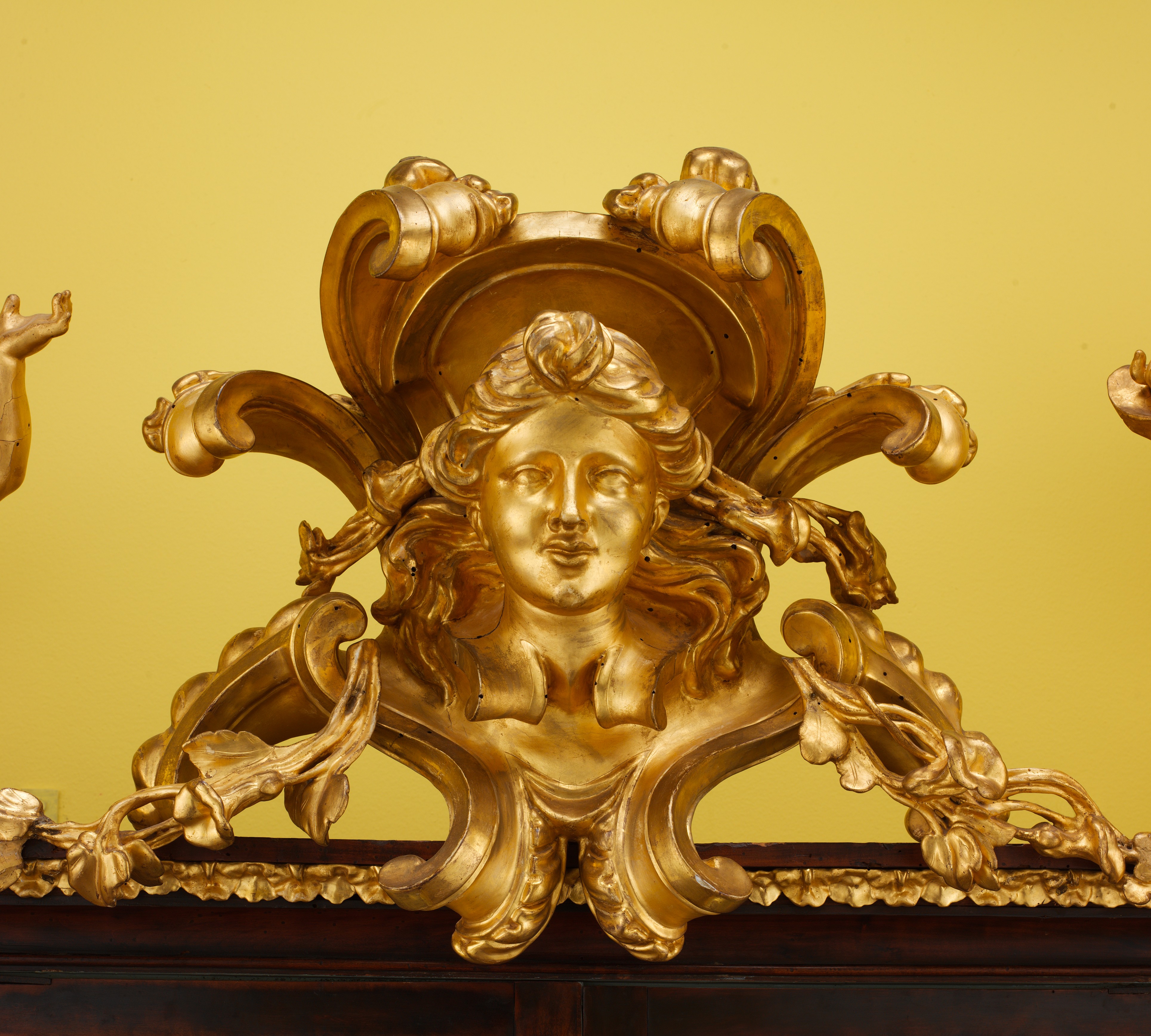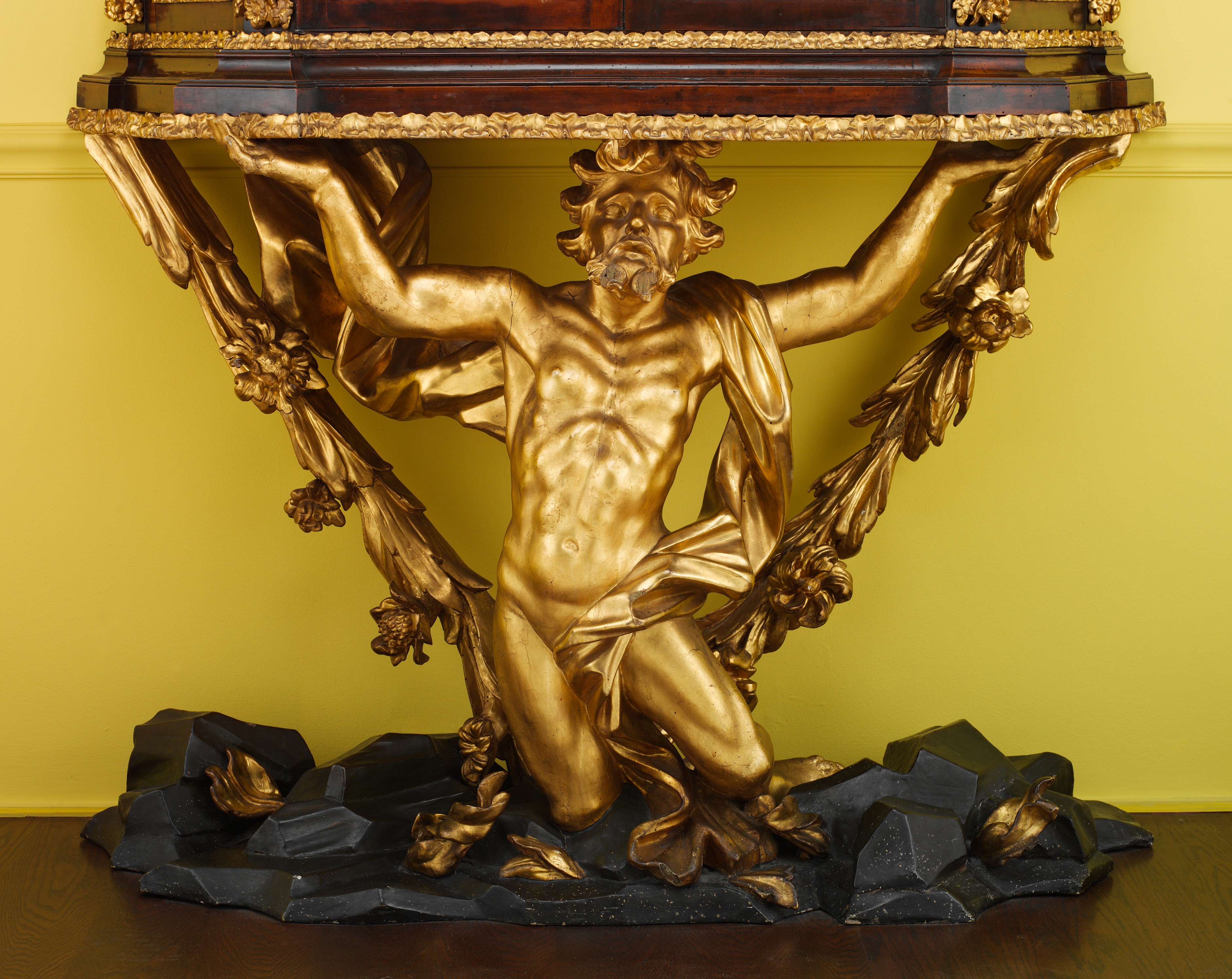Showcase on stand (Scarabattola)
Not on view
With its strong sculptural character and striking theatricality, this vitrine, or scarabattola, is a beautiful example of Roman Baroque furniture. [1] Strictly symmetrical in its decoration, the piece consists of an upper section, the actual display cabinet with its glazed doors and splayed sides, and the stand below, with its bearded atlas who seems to carry the weight of the top nonchalantly on his extended palms. This entirely gilded figure is kneeling on the representation of a rocky ground that has been painted dark green and has tufts of gilded grass. A sense of dynamism is achieved through the muscularity of his slightly twisted body, the luxurious curls, and the swirling drapery that conceals his nudity. The atlas is framed by a large floral swag extending from the corners at the back of the vitrine down to the base. Directing the viewer's attention to the central crest ornament, four joyfully gesticulating putti perched on the cabinet with their festoons of flowers create a feeling of vivacity and movement, while in the center a female mask set against a large scrolling cartouche augments the overall sculptural richness. Additional gilded carving, in the form of winged caryatids with feathered headdresses emerging from pendant floral swags, embellishes the stiles of the cabinet.
The painter, architect, and preeminent sculptor Gianlorenzo Bernini (1598-1680) exerted a profound influence on the decorative arts of the Roman Baroque. [2] His novel use of color is reflected in the strong contrast between the walnut and the gilded and painted surfaces of this cabinet. The sense of movement and emotion that the artist instilled in his figural compositions is most clearly echoed here in the effortless strength of the atlas and in the frolicking putti.
Showcases of this kind were commissioned to hold an array of small precious objects. Between 1726 and 1729, for instance, the carver Anton Francesco Gonnelli (1688-1735) executed three impressive scarabattole to hold the amber and ivory collections of the Medici grand dukes in Florence. [3] More than utilitarian pieces of furniture, these splendid vitrines became works of art in their own right. The mirrored inner back of the Museum's cabinet makes it possible to view simultaneously from the front and from behind the treasures placed inside and, through reflection, doubles them in number.
Unfortunately, little is known about the early history of this important display case. It came to the Museum as the gift of Lilliana Teruzzi, one of the Metropolitan's more colorful benefactors. [4] Born Lilliana Weinman, she became an opera singer known professionally as Lilliana Lorma and performed in Europe during the 1920s and 1930s, when she was briefly married to the Italian Fascist general Attilio Teruzzi (1882-1950). According to the donor, she acquired this piece of furniture in 1933 from Prince Cesare Ludovico Ottoboni (b. 1888). He was a descendant of a prestigious noble family who counted Pope Alexander VIII (1610-1691) and his grandnephew Cardinal Pietro Ottoboni (1667-1740) among its members. The latter was a great patron of the arts, whose opulent Roman residence, the palace of the Cancelleria, was described by Pietro Rossini in a contemporary guidebook, Mercurio errante delle grandezze di Roma (1693), as one of the most culturally active courts in Rome. [5] It is known that Ottoboni had several cases for medals, and others to hold his large collection of medallions; in the absence of further documentation, one can only wonder if the Museum's piece was one of these cabinets. [6] At the time of his death Cardinal Ottoboni left more than four hundred paintings, most of which he had inherited from Pope Alexander VIII, as well as many debts. As a result, his art collections and the furnishings of his palace were immediately dispersed. [7]
Footnotes:
1. Metropolitan Museum of Art 1975, p. 259 (entry by Penelope Hunter-Stiebel).
2. Walker 1999, pp. 3-6.
3. Colle 1997, pp. 82-83, pls. XVIII, XIX, pp. 180-85, nos. 52, 53 (entries by Enrico Colle).
4. See Draper 1994, pp. 20-21.
5. Olszewski 1999, p. 93.
6. Olszewski 2004, pp. 16, 221.
7. Olszewski 1989, p. 33.
Due to rights restrictions, this image cannot be enlarged, viewed at full screen, or downloaded.
This artwork is meant to be viewed from right to left. Scroll left to view more.





